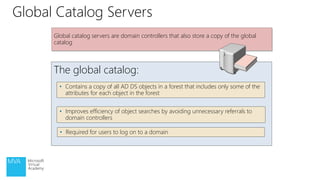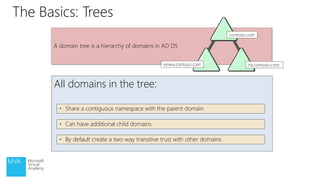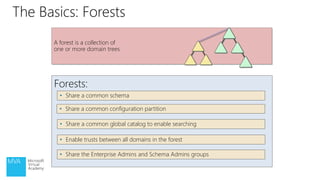02-Active Directory Domain Services.pptx
- 2. • Overview of AD DS • AD DS Physical Components • AD DS Logical Components Module Overview
- 3. • What is Active Directory? – A collection of services (Server Roles and Features) used to manage identity and access for and to resources on a network What is Active Directory Domain Services • Internal Accounts • Authorization • Authentication Federation Services • Network Access for External Resources Certificate Services • Identity • Non- Repudiation Rights Management Services • Content Security and Control Lightweight Directory Services • Application Templates Active Directory • Identity • Access • Centralized Management
- 4. • AD Domain Services (AD DS) – Users, Computers, Policies • AD Certificate Services (AD CS) – Service, Client, Server and User identification • AD Federation Services (AD FS) – Resource access across traditional boundaries • AD Rights Management Services (AD RMS) – Maintain security of data • AD Lightweight Directory Services (AD LDS) Active Directory Roles
- 5. • What is Active Directory Domain Services? – A directory service is both the directory information source and the service that makes the information available and usable – A phone book… What is AD DS? Windows Server • Mgmt Profile • Network Info • Printers • Shares Windows User • Account Information • Privileges • Profiles • Policies Windows Client • Mgmt Profile • Network Info • Policies Email Servers • Mailbox Information • Address Book Applications • Server Config • SSO • App-Specific Directory Info Network Devices • Config • QoS Policy • Security Policy Active Directory Domain Services • Manageability • Security • Interoperability
- 6. • Scalable, secure, and manageable infrastructure for user and resource management – stores and manages information about network resources – provides support for directory-enabled applications such as Microsoft® Exchange Server – allows for centralized management – AD DS provides built in replication and redundancy: if one Domain Controller (DC) fails, another DC picks up the load – All access to network resources goes through AD DS, which keeps network access rights management centralized – Easily Integrated with Network Devices (ex: Radius, etc) What does AD DS do?
- 7. • Protocol • What is Authentication? • What is Authorization? • Why Deploy AD DS? • Centralized Network Management • Requirements for Installing AD DS • Overview of AD DS and DNS • Overview of AD DS Components Lesson 1: Overview of AD DS
- 8. Protocol • Lightweight Directory Access Protocol (LDAP) – X.500 Standard – Based on TCP/IP – A method for accessing, searching, and modifying a directory service – A client-server model
- 9. What is Authentication? Authentication includes two components: Authentication is the process of verifying a user’s identity on a network • Network authentication: grants access to network resources • Interactive logon: grants access to the local computer
- 10. What is Authorization? Security principals are issued security identifiers (SIDs) when the account is created User accounts are issued security tokens during authentication that include the user’s SID and all related group SIDs Shared resources on a network include access control lists (ACL) that define who can access the resource Authorization is a process of verifying that an authenticated user has permission to perform an action The security token is compared against the Discretionary Access Control List (DACL) on the resource and access is granted or denied
- 11. Why Deploy AD DS? AD DS features include: • Centralized directory • Single sign-on access • Integrated security • Scalability AD DS provides a centralized system for managing users, computers, and other resources on a network • Common management interface
- 12. Centralized Network Management AD DS centralizes network management by providing: • Single location and set of tools for managing user and group accounts • Single location for assigning access to shared network resources • Directory service for AD DS enabled applications • Options for configuring security policies that apply to all users and computers • Group policies to manage user desktops and security settings
- 13. Object Description TCP/IP • Configure appropriate TCP/IP and DNS server addresses. Credentials • To install a new AD DS forest, you need to be local Administrator on the server. To install an additional domain controller in an existing domain, you need to be a member of the Domain Admins group. Domain Name System )DNS) Infrastructure • Verify that a DNS infrastructure is in place. When you install AD DS, you can include DNS server installation, if it is needed. • When you create a new domain, a DNS delegation is created automatically during the installation process. Creating a DNS delegation requires credentials that have permissions to update the parent DNS zones. Requirements for Installing AD DS
- 14. Overview of AD DS and DNS AD DS domain controller records must be registered in DNS to enable other domain controllers and client computers to locate the domain controllers AD DS domain names must be DNS domain names DNS Domain Name AD DS requires a DNS infrastructure DNS DNS zones can be stored in AD DS as Active Directory integrated zones DNS Zone
- 15. Physical Components Logical Components • Data store • Domain controllers • Global catalog server • Read-Only Domain Controller (RODC) • Partitions • Schema • Domains • Domain trees • Forests • Sites • Organizational units (OUs) AD DS is composed of both physical and logical components Component Overview
- 16. Lesson 2: Overview of AD DS Physical Components • Domain Controllers • Global Catalog Servers • Data Store • Replication • Sites
- 17. Domain Controllers Domain controllers: • Host a copy of the AD DS directory store • Provide authentication and authorization services • Replicate updates to other domain controllers in the domain and forest A domain controller is a server with the AD DS server role installed that has specifically been promoted to a domain controller • Allow administrative access to manage user accounts and network resources Windows Server 2008 and later supports RODCs
- 18. Global Catalog Servers The global catalog: • Contains a copy of all AD DS objects in a forest that includes only some of the attributes for each object in the forest • Improves efficiency of object searches by avoiding unnecessary referrals to domain controllers • Required for users to log on to a domain Global catalog servers are domain controllers that also store a copy of the global catalog
- 19. What is the AD DS Data Store? The AD DS data store: • Consists of the Ntds.dit file • Is stored by default in the %SystemRoot%NTDS folder on all domain controllers • Is accessible only through the domain controller processes and protocols The AD DS data store contains the database files and processes that store and manage directory information for users, services, and applications
- 20. What is AD DS Replication? AD DS replication: • Ensures that all domain controllers have the same information • Uses a multimaster replication model • Can be managed by creating AD DS sites AD DS replication copies all updates of the AD DS database to all other domain controllers in a domain or forest The AD DS replication topology is created automatically as new domain controllers are added to the domain
- 21. What are Sites? Sites are: • Associated with IP subnets • Used to manage replication traffic • Used to manage client logon traffic An AD DS site is used to represent a network segment where all domain controllers are connected by a fast and reliable network connection • Used by site aware applications such as Distributed File Systems (DFS) or Exchange Server • Used to assign group policy objects to all users and computers in a company location
- 22. Lesson 3: Overview of AD DS Logical Components • AD DS Schema • The Basics • Trusts • AD DS Objects
- 23. The AD DS Schema: • Defines every type of object that can be stored in the directory • Enforces rules regarding object creation and configuration Object Types Function Examples Class Object What objects can be created in the directory • User • Computer Attribute Object Information that can be attached to an object • Display name What is the AD DS Schema?
- 24. The Basics: Domains Domains: • An administrative boundary for applying policies to groups of objects • A replication boundary for replicating data between domain controllers • An authentication and authorization boundary that provides a way to limit the scope of access to resources Contoso.com Domains are used to group and manage objects in an organization
- 25. The Basics: Trees All domains in the tree: • Share a contiguous namespace with the parent domain • Can have additional child domains • By default create a two-way transitive trust with other domains A domain tree is a hierarchy of domains in AD DS contoso.com na.contoso.com emea.contoso.com
- 26. The Basics: Forests Forests: • Share a common schema • Share a common configuration partition • Share a common global catalog to enable searching A forest is a collection of one or more domain trees • Enable trusts between all domains in the forest • Share the Enterprise Admins and Schema Admins groups
- 27. The Basics: Organizational Units (OUs) OUs are used to: • Represent your organization hierarchically and logically • Manage a collection of objects in a consistent way • Delegate permissions to administer groups of objects OUs are Active Directory containers that can contain users, groups, computers, and other OUs • Apply policies
- 28. The Basics: Organizational Units (OUs)
- 29. Trusts provide a mechanism for users to gain access to resources in another domain Types of Trusts Description Diagram Directional The trust direction flows from trusting domain to the trusted domain Transitive The trust relationship is extended beyond a two-domain trust to include other trusted domains • All domains in a forest trust all other domains in the forest • Trusts can extend outside the forest Access TRUST Trust & Access Trusts
- 30. Object Description User • Enables network resource access for a user InetOrgPerson • Similar to a user account • Used for compatibility with other directory services Contacts • Used primarily to assign e-mail addresses to external users • Does not enable network access Groups • Used to simplify the administration of access control Computers • Enables authentication and auditing of computer access to resources Printers • Used to simplify the process of locating and connecting to printers Shared folders • Enables users to search for shared folders based on properties AD DS Objects
- 31. ©2013 Microsoft Corporation. All rights reserved. Microsoft, Windows, Office, Azure, System Center, Dynamics and other product names are or may be registered trademarks and/or trademarks in the U.S. and/or other countries. The information herein is for informational purposes only and represents the current view of Microsoft Corporation as of the date of this presentation. Because Microsoft must respond to changing market conditions, it should not be interpreted to be a commitment on the part of Microsoft, and Microsoft cannot guarantee the accuracy of any information provided after the date of this presentation. MICROSOFT MAKES NO WARRANTIES, EXPRESS, IMPLIED OR STATUTORY, AS TO THE INFORMATION IN THIS PRESENTATION.
Editor's Notes
- 1
- 2 minutes Active Directory is a collection of services (Server Roles and Features) used to manage identity and access for and to resources on a network.
- 2 minutes In the next few slides you will cover each of these Windows Roles with a summary of what each is and what each does.
- 5 Minutes Use the phone book
- Course 6424A
- Course 6424A
- Course 6424A
- Course 6424A
- Course 6424A
- Course 6424A
- Course 6424A
- Course 6424A
- Course 6424A
- Course 6424A
- Course 6424A
- Course 6424A
- Course 6424A
- All of the domain controllers in a particular domain can receive changes and replicate those changes to all other domain controllers in the domain. Each domain in Active Directory is identified by a Domain Name System (DNS) domain name and requires one or more domain controllers.
- Course 6424A
- Course 6424A
- Course 6424A
- Course 6424A
- Course 6424A
- Course 6424A
- Course 6424A
- Course 6424A
- Course 6424A






























